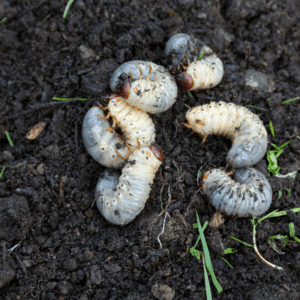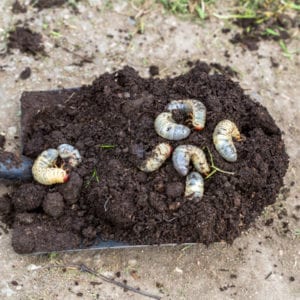Grubs; These Tiny Lawn Destroyers Pack a Massive Punch!
It’s summertime in Pennsylvania, and that means longer nights and hotter days. With most concerts, festivals and large events being canceled, now more than ever, your family will be spending more time in your own backyard. But there are tons of things out to destroy your lawn, creating damage that can hinder your outdoor fun and create a nasty eyesore on your lawn. These white ugly, worm-like creatures are called grubs.

Pennsylvania Lawns Are Under Attack!
Grubs are by far one of the biggest threats to Pennsylvania lawns. These tiny beetle larvae have giant-sized appetites, and your grass is their favorite meal. In technical terms, grubs are the larvae of scarab beetles. If you’ve ever seen one, you know that they sort of look like a cross between a worm and a caterpillar. Either way, they can be disturbing for both you and your lawn.
Adult grubs seek out cozy spots in your turf to lay their eggs and bury them right underneath the surface. This makes them hard to spot. The eggs take anywhere from six to 50 days to hatch and move onto the next step of larvae. Once they hatch, they begin to feed on your lawn’s roots devouring everything in sight. Even the healthiest and robust greens can fall prone to the devastating damage grubs can cause.
Symptoms of a Grub Problem
The first sign of a grub problem is noticing that parts of your grass are turning brown or dying. Brown patches and wilting grass show up in random spots throughout your lawn. Your grass may feel unusually soft while you walk on it, giving way. Moles and other wildlife begin to rip up your lawn, creating holes where they create tunnels, foraging for food. While we might think grubs are gross, moles, raccoons, skunks, and other medium-sized animals consider grubs a gourmet meal. A lawn infested with grubs will usually attract these types of animals causing you even more lawn damage as they rip up your turf.
How Do I Know for Sure if it’s Grubs?
Grubs are tiny and bury inside your soil, making them hard to find. The best way to determine if you have a grub problem is to call in the professionals at Showcase Lawn Works. However, there are a few tried and true methods you can use. Take a shovel and dig up a section of your lawn where you suspect the varmints live. Make sure to check a few spots. If grubs are there, you will spot them. Another way to look for these pesky lawn destroyers is by tugging on a soft, spongy area of your grass. If it pulls up like a piece of carpet, you most likely have a grub problem.

Grub Prevention
Preventing grubs is not always easy. Grubs are always searching for their next lawn. However, a healthy and robust lawn will be better able to fight off a grub infestation should one occur. The best way to prevent a grub problem is through year-round care and a fertilization program such as the one we offer at Showcase Lawn Works. Our Standard Lawn Care Program provides an organic-based fertilizer and broadleaf weed control to strengthen your grass, making it more resistant to pests, weeds, stress, traffic, and drought.
Unfortunately, even the healthiest and robust lawns can get infested with grubs. This is why we offer a Grub Control Program as an add-on service for customers with a severe grub problem. Contact us now to learn more about our Grub Control Program and how we can help you eliminate this root destroyer and get you back to enjoying your lawn. Or give us a call at 717-354-3226. Our staff is always available. Get to know us on a more personal level by liking us on Facebook.